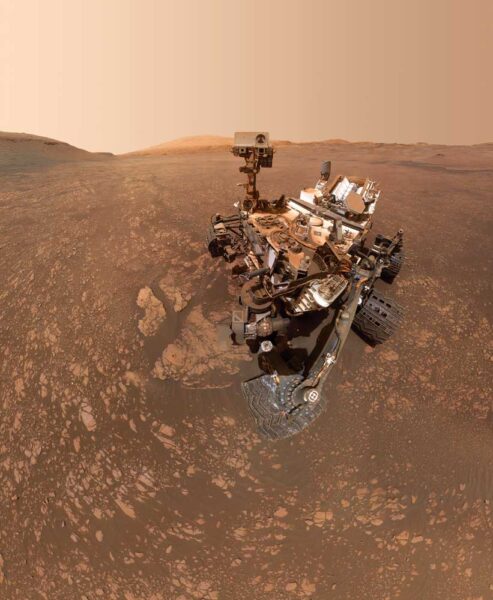What’s behind the strangely fluctuating levels of oxygen on the Red Planet?

NASA / JPL-Caltech / MSSS
The Curiosity rover has now been on Mars for seven years, and in its slow but steady ramble across Gale Crater and up the lower slopes of Mount Sharp, it has taught us much about the Red Planet’s ancient geology and chemistry. Most significant has been its confirmation of early Mars’s wet environments. But some of its most enigmatic findings have come from sampling and analyzing the current local air.
First there was the methane, which shouldn’t be there (S&T: July 2019, p. 9). Methane’s “lifetime” — how long molecules should survive in the face of known destructive mechanisms — is far too short for accumulations even in the tiny amounts seen. Yet Curiosity has detected bursts of up to 21 parts per billion by volume that seemed to come and go rapidly.
Unexpected methane in a planetary atmosphere has long been held up as a potential “biosignature.” That’s because here on Earth, organisms produce most of the methane in our air.
Now comes a new report about molecular oxygen (O2). The report draws from data collected by the Sample Analysis at Mars instrument — the rover’s suite of chemistry experiments.
Unlike methane, we expect oxygen on Mars. The atmosphere contains carbon dioxide, water vapor, and other oxygen-carrying molecules, and it is bathed in ultraviolet and cosmic radiation that can rip these molecules apart, leaving free oxygen atoms to combine with each other. So it should be there in the trace amounts we observe. But what’s strange about the O2 abundances Curiosity has recorded is the way that they fluctuate over time. Oxygen appears in the spring, its abundance rises rapidly, and then it disappears in the fall and winter. It also seems to vary widely from year to year.
We expect all atmospheric gases to vary seasonally on Mars, following the now-understood variations in atmospheric pressure that arise from the freezing and thawing of carbon dioxide at alternating poles. Yet oxygen’s spring rise and winter low are too extreme. Something else is going on.
Any planetary mystery involving oxygen gets our attention because, like methane, it’s a potential biosignature. Oxidation, which oxygen and other elements perform, is integral to our notions of life. Even when we try to be open-minded about potential alien life, it’s hard to imagine it not needing some kind of “redox” reaction (shorthand for oxidation and reduction). Life at its most basic involves a redox exchange of electrons between “donor” and “receptor” molecules. This is the essential trade upon which all of the chemistry, metabolism, and structure of life rests.
So is this evidence for life on Mars? Almost surely not, although it’s fun to speculate. I suspect that the same extreme reactivity of oxygen that makes it so indispensable to life will ultimately explain the conundrum. There’s a lot we don’t know about the near-surface chemistry of Mars, but we do know about reactive, oxygen-containing molecules such as hydrogen peroxide and perchlorates, which permeate the Martian regolith. My bet is that the springtime wave of both warmth and atmospheric pressure is stimulating some as-yet-unknown chemistry in the soil to burp out this surprising puff of O2.
But at the moment all we can do is savor this delightful puzzle and resolve to keep exploring.
This article originally appeared in print in the March 2020 of Sky & Telescope.
 0
0
Comments
You must be logged in to post a comment.